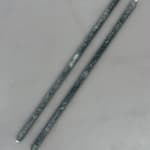-
Lou Jaworski
LA NOTTE – MICHELANGELO 2021 RE EDIT, 2021Handcut and polished serpentino marble, aluminum and steel2 parts, each 122 x 3 cmCopyright The ArtistPhoto: Lou JaworskiWeitere Abbildungen
Lou Jaworskis Wandarbeit LA NOTTE – MICHELANGELO 2021 RE EDIT (2021) erinnert auf den ersten Blick an handelsübliche Neon-Leuchtstoffröhren, erst beim Nähertreten ist erkennbar, dass es sich um Stäbe aus...Lou Jaworskis Wandarbeit LA NOTTE – MICHELANGELO 2021 RE EDIT (2021) erinnert auf den ersten Blick an handelsübliche Neon-Leuchtstoffröhren, erst beim Nähertreten ist erkennbar, dass es sich um Stäbe aus schwarzem Marmor handelt. Jaworski lotet in seinen Arbeiten häufig die Grenzen von Materialien aus. In LA NOTTE – MICHELANGELO 2021 RE EDIT schneidet er dünne Zylinder aus schwarzem Serpentino Marmor und gibt der massiven Materialität des Steins die zerbrechliche Eigenschaft von Glas.
Das Aufkommen von Neonlicht hatte – vorrangig in öffentlichen Gebäuden und im Stadtbild – Auswirkungen auf die Wahrnehmung von Räumen und wie diese, durch flächendeckende, farbige Beleuchtung oder Schriftzüge, gestaltet wurden. Den perzeptiven Einfluss von Neonlicht auf das alltägliche Leben wurde von Künstler/innen in kreative Prozesse aufgenommen und steht heute in einer langen materialästhetischen Tradition. Jaworski greift dies auf und überführt das serielle Industrieprodukt der Leuchtstoffröhre in handwerklichem Geschick zurück, in das traditionellste skulpturale Material, den Stein und schafft somit eine Ambivalenz zwischen Materialität, Wertigkeit und industriellem Fortschritt. Besonders bei LA NOTTE – MICHELANGELO 2021 RE EDIT (2021) zeigt sich die Ambivalenz und Mehrdeutigkeit der Arbeitsweise Jaworskis. Sowohl der Titel der Arbeit, der schnell mit Michelangelo Buonarotti assoziiert werden könnte, allerdings von Michelangelo Antonionis Film „La notte“ inspiriert ist, als auch die dunkle Farbigkeit einer eigentlich hell leuchtenden Neon-Leuchtstoffröhre, weisen auf Lou Jaworskis vielschichtige Arbeit hin.
At first glance, Lou Jaworski's wall piece LA NOTTE - MICHELANGELO 2021 RE EDIT (2021) resembles standard neon fluorescent tubes; only upon closer inspection is it apparent that they are actual black marble columns. Jaworski often explores the limits of materials in his works. In LA NOTTE - MICHELANGELO 2021 RE EDIT, he cuts thin cylinders of black Serpentino marble, giving the solid materiality of stone the fragile quality of glass.
The advent of neon lighting had an impact - primarily in public buildings and in the cityscape - on the perception of spaces and how they were designed, through blanket, colored lighting or lettering. The perceptive influence of neon light on everyday life was taken up by artists in creative processes and is today part of a long material-aesthetic tradition. Jaworski references these and transfers the serial industrial product of the fluorescent tube back into the most traditional sculptural material, the stone, thus creates an ambivalence between materiality, value and industrial progress. The ambivalence and ambiguity of Jaworski's working method is particularly evident in LA NOTTE - MICHELANGELO 2021 RE EDIT (2021). Both the title of the work, which could quickly be associated with Michelangelo Buonarotti, but is inspired by Michelangelo Antonioni's film "La notte", and the dark coloration of a neon fluorescent tube that actually shines brightly, point to Lou Jaworski's multi-layered work.





